Search
- Page Path
-
- HOME
- Search
- Original Article
- Gastroenterology
- Influence of proton pump inhibitor therapy on intestinal inflammation assessed by fecal calprotectin in pediatric patients
- Su Yeong Kim, Na Mi Lee, Sin Weon Yun, Soo Ahn Chae, In Seok Lim, Eung Sang Choi, Dae Yong Yi
- Clin Exp Pediatr. 2019;62(10):400-404. Published online July 3, 2019
-

Background: An increase in the numbers of patients with gastrointestinal symptoms has recently been observed.
Purpose: To investigate the effects of proton pump inhibitor (PPI) therapy on intestinal inflammation in children and adolescents as confirmed by clinical manifestations and objectively assessed by fecal calprotectin (FC) level measurement. Methods: Consecutive children (aged 3–18 years) who presented with gastrointestinal symptoms and were treated with...
- Review Article
- Gastroenterology
- The role of fecal calprotectin in pediatric disease
- Su Jin Jeong
- Clin Exp Pediatr. 2019;62(8):287-291. Published online March 28, 2019
-

Fecal calprotectin (FC) is a calcium- and zinc-binding protein of the S100 family, mainly expressed by neutrophils and released during inflammation. FC became an increasingly useful tool both for gastroenterologists and for general practitioners for distinguishing inflammatory bowel disease (IBD) from irritable bowel syndrome. Increasing evidences support the use of this biomarker for diagnosis, follow-up and evaluation of response to...
- Nutrition
- A perspective on partially hydrolyzed protein infant formula in nonexclusively breastfed infants
- Yvan Vandenplas, Zakiudin Munasir, Badriul Hegar, Dewi Kumarawati, Ahmad Suryawan, Muzal Kadim, Julistio Tb Djais, Ray Wagiu Basrowi, Deni Krisnamurti
- Clin Exp Pediatr. 2019;62(5):149-154. Published online January 14, 2019
-

The World Health Organization recommends that infants should be exclusively breastfed for the first 6 months of life to provide optimal nutrition in this critical period of life. After this, infants should receive nutritionally adequate and safe complementary foods while breastfeeding continues for up to 2 years of age or beyond. For nonbreastfed infants, infant formula is an available option...
- Original Article
- Risk factors for the occurrence and persistence of coronary aneurysms in Kawasaki disease
- Soo-kyeong Jeon, Geena Kim, Hoon Ko, Joung-Hee Byun, Hyoung Doo Lee
- Clin Exp Pediatr. 2019;62(4):138-143. Published online November 22, 2018
-
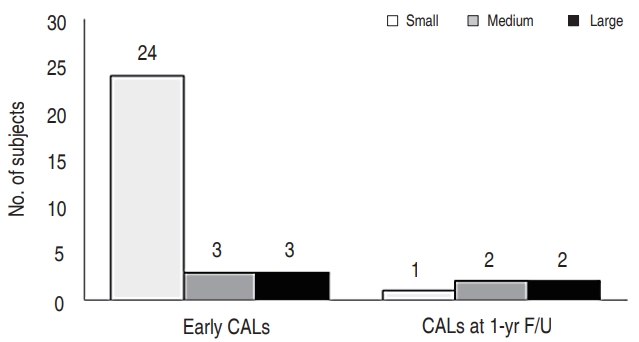
Purpose: Prognostic factors of coronary aneurysms in Kawasaki disease have been investigated in many studies. The aim of this study was to identify risk factors associated with early and late coronary artery outcomes in treated patients with Kawasaki disease. Methods: A total of 392 patients diagnosed with Kawasaki disease from January 2012 to December 2015 in Pusan National University Children’s Hospital...
- Cardiology
- The change of QRS duration after pulmonary valve replacement in patients with repaired tetralogy of Fallot and pulmonary regurgitation
- Yuni Yun, Yeo Hyang Kim, Jung Eun Kwon
- Clin Exp Pediatr. 2018;61(11):362-365. Published online October 24, 2018
-
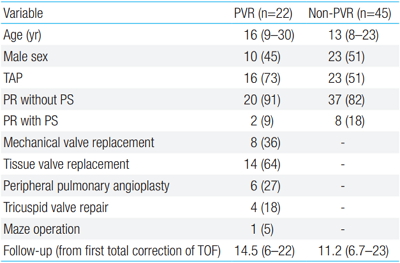
Purpose: This study aimed to analyze changes in QRS duration and cardiothoracic ratio (CTR) following pulmonary valve replacement (PVR) in patients with tetralogy of Fallot (TOF). Methods: Children and adolescents who had previously undergone total repair for TOF (n=67; median age, 16 years) who required elective PVR for pulmonary regurgitation and/or right ventricular out tract obstruction were included in this study....
- Neonatology (Perinatology)
- Clinical features and prognostic factors of early-onset sepsis: a 7.5-year experience in one neonatal intensive care unit
- Se Jin Kim, Ga Eun Kim, Jae Hyun Park, Sang Lak Lee, Chun Soo Kim
- Clin Exp Pediatr. 2019;62(1):36-41. Published online September 27, 2018
-
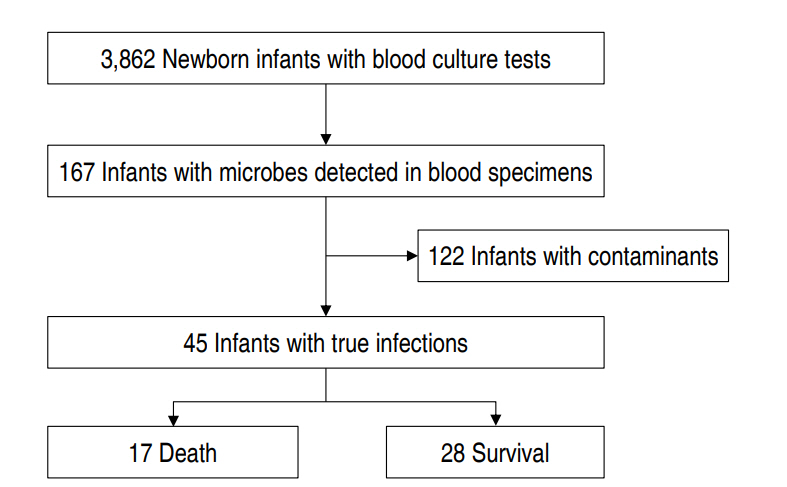
Purpose: In this study, we investigated the clinical features and prognostic factors of early-onset sepsis (EOS) in neonatal intensive care unit (NICU) patients. Methods: A retrospective analysis was conducted on medical records from January 2010 to June 2017 (7.5 years) of a university hospital NICU. Results: There were 45 cases of EOS (1.2%) in 3,862 infants. The most common pathogen responsible for...
- Allergy
- Common features of atopic dermatitis with hypoproteinemia
- So Yoon Jo, Chan-Ho Lee, Woo-Jin Jung, Sung-Won Kim, Yoon-Ha Hwang
- Clin Exp Pediatr. 2018;61(11):348-354. Published online September 16, 2018
-
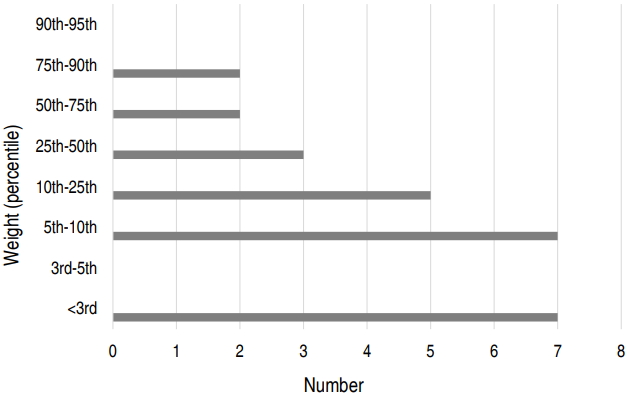
Purpose: The purpose of this study was to identify the causes, symptoms, and complications of hypoproteinemia to prevent hypoproteinemia and provide appropriate treatment to children with atopic dermatitis. Methods: Children diagnosed with atopic dermatitis with hypoproteinemia and/or hypoalbuminemia were retrospectively reviewed. The patients’ medical records, including family history, weight, symptoms, treatment, complications, and laboratory test results for allergies and skin cultures,...
- Infection
- Usefulness of the procalcitonin test in young febrile infants between 1 and 3 months of age
- In Sul Lee, Young Jin Park, Mi Hyeon Jin, Ji Young Park, Hae Jeong Lee, Sung Hoon Kim, Ju Suk Lee, Cheol Hong Kim, Young Don Kim, Jun Hwa Lee
- Clin Exp Pediatr. 2018;61(9):285-290. Published online September 15, 2018
-
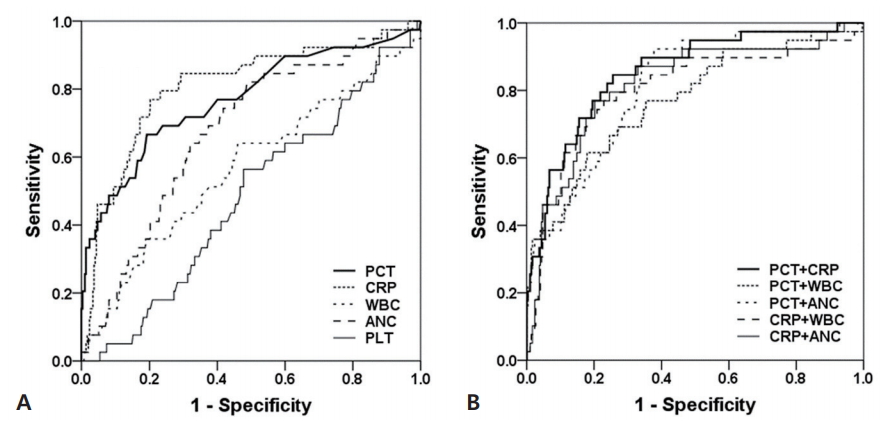
Purpose: To study the usefulness of the procalcitonin (PCT) test in young febrile infants between 1 and 3 months of age. Methods: We evaluated the medical records of 336 febrile infants between 1 and 3 months of age who visited the Emergency Department or outpatient department of Samsung Changwon Hospital from May 2015 to February 2017, and analyzed the clinical characteristics...
- Pulmonology
- Increased procalcitonin level is a risk factor for prolonged fever in children with Mycoplasma pneumonia
- Ji Eun Jeong, Ji Eun Soh, Ji Hee Kwak, Hye Lim Jung, Jae Won Shim, Deok Soo Kim, Moon Soo Park, Jung Yeon Shim
- Clin Exp Pediatr. 2018;61(8):258-263. Published online August 15, 2018
-
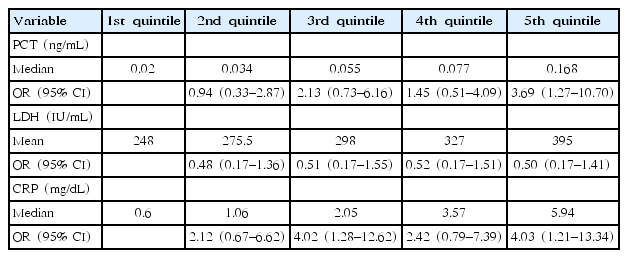
Purpose: Macrolide-resistant Mycoplasma pneumoniae pneumonia (MPP) is characterized by prolonged fever and radiological progression despite macrolide treatment. Few studies have examined serum procalcitonin (PCT) level in children with MPP. We aimed to investigate the association of acute inflammation markers including PCT with clinical parameters in children with MPP. Methods: A total of 147 children were recruited. The diagnosis of MPP...
- Neonatology (Perinatology)
- The impact of a quality improvement effort in reducing admission hypothermia in preterm infants following delivery
- Han Saem Choi, Soon Min Lee, Hoseon Eun, Minsoo Park, Kook-In Park, Ran Namgung
- Clin Exp Pediatr. 2018;61(8):239-244. Published online August 15, 2018
-
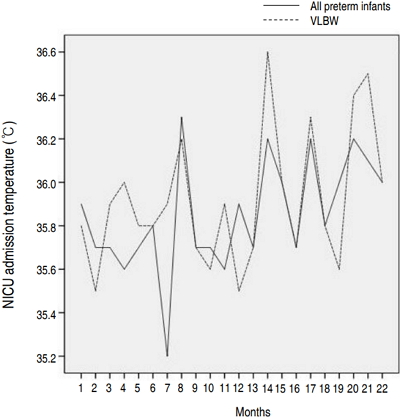
Purpose: Hypothermia at admission is associated with increased mortality and morbidity in preterm infants. We performed a quality improvement (QI) effort to determine the impact of a decrease in admission hypothermia in preterm infants. Methods: The study enrolled very low birth weight (VLBW) infants born at Gangnam Severance Hospital between January 2013 and December 2016. This multidisciplinary QI effort included the...
- Infection
- Clinical and laboratory profiles of hospitalized children with acute respiratory virus infection
- Eunjin Choi, Kee-Soo Ha, Dae Jin Song, Jung Hwa Lee, Kwang Chul Lee
- Clin Exp Pediatr. 2018;61(6):180-186. Published online June 25, 2018
-

Purpose Despite the availability of molecular methods, identification of the causative virus in children with acute respiratory infections (ARIs) has proven difficult as the same viruses are often detected in asymptomatic children.
Methods Multiplex reverse transcription polymerase chain reaction assays were performed to detect 15 common respiratory viruses in children under 15 years of age who were hospitalized with ARI between January 2013...
- Cardiology
- Clinical implications in laboratory parameter values in acute Kawasaki disease for early diagnosis and proper treatment
- Yu-Mi Seo, Hyun-Mi Kang, Sung-Churl Lee, Jae-Won Yu, Hong-Ryang Kil, Jung-Woo Rhim, Ji-Whan Han, Kyung-Yil Lee
- Clin Exp Pediatr. 2018;61(5):160-166. Published online May 28, 2018
-
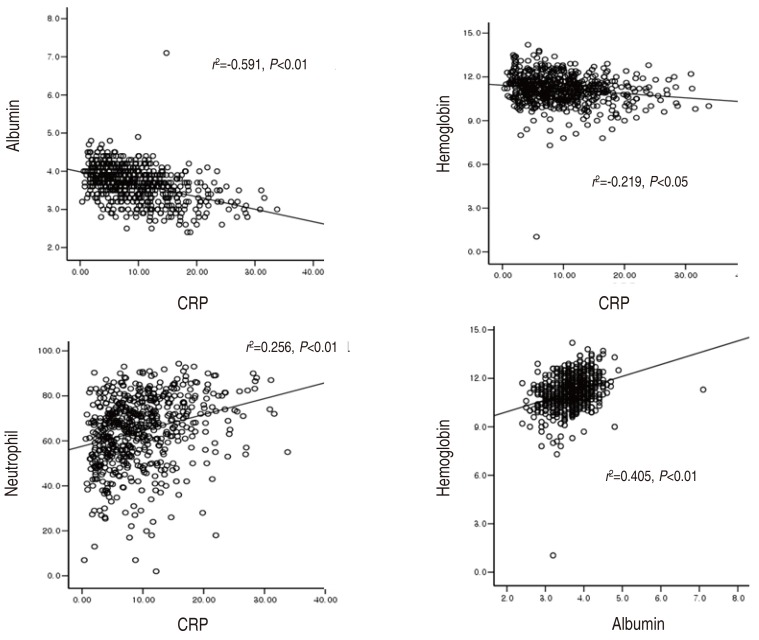
Purpose This study aimed to analyse laboratory values according to fever duration, and evaluate the relationship across these values during the acute phase of Kawasaki disease (KD) to aid in the early diagnosis for early-presenting KD and incomplete KD patients.
Methods Clinical and laboratory data of patients with KD (n=615) were evaluated according to duration of fever at presentation, and were compared between...
- Neonatology (Perinatology)
- Diagnostic and prognostic value of proadrenomedullin in neonatal sepsis
- Sameh Samir Fahmey, Heba Mostafa, Noha Abd Elhafeez, Heba Hussain
- Clin Exp Pediatr. 2018;61(5):156-159. Published online May 28, 2018
-

Purpose Sepsis is a major cause of neonatal morbidity and mortality. Early diagnosis is a major problem because of the lack of specific clinical signs. Therefore, a reliable diagnostic marker is needed to guide the use of antimicrobial agents. The objective of our study was to assess the value of proadrenomedullin (pro-ADM) in establishing the diagnosis and evaluating the prognosis of...
- Oncology
- Excellent treatment outcomes in children younger than 18 months with stage 4
MYCN nonamplified neuroblastoma - Chiwoo Kim, Young Bae Choi, Ji Won Lee, Keon Hee Yoo, Ki Woong Sung, Hong Hoe Koo
- Clin Exp Pediatr. 2018;61(2):53-58. Published online February 28, 2018
-

Purpose Although the prognosis is generally good in patients with intermediate-risk neuroblastoma, no consensus has been reached on the ideal treatment regimen. This study analyzed treatment outcomes and toxicities in patients younger than 18 months with stage 4
MYCN nonamplified neuroblastoma.Methods We retrospectively analyzed 20 patients younger than 18 months newly diagnosed with stage 4
MYCN nonamplified neuroblastoma between January 2009 and...
- Infection
- Treatment-failure tularemia in children
- Arzu Karlı, Gülnar Şensoy, Şule Paksu, Muhammet Furkan Korkmaz, Ömer Ertuğrul, Rıfat Karlı
- Clin Exp Pediatr. 2018;61(2):49-52. Published online February 28, 2018
-
Purpose Tularemia is an infection caused by
Francisella tularensis . Its diagnosis and treatment may be difficult in many cases. The aim of this study was to evaluate treatment modalities for pediatric tularemia patients who do not respond to medical treatment.Methods A single-center, retrospective study was performed. A total of 19 children with oropharyngeal tularemia were included.
Results Before diagnosis, the duration of symptoms in...
- Cardiology
- C-reactive protein and N-terminal pro-brain natriuretic peptide discrepancy: a differentiation of adenoviral pharyngoconjunctival fever from Kawasaki disease
- Jung Eun Choi, Hee Won Kang, Young Mi Hong, Sejung Sohn
- Clin Exp Pediatr. 2018;61(1):12-16. Published online January 22, 2018
-
Purpose To differentiate adenoviral pharyngoconjunctival fever (PCF) from acute Kawasaki disease (KD) using laboratory tests before results of virus-real time polymerase chain reaction and ophthalmologic examination are obtained.
Methods Baseline patient characteristics and laboratory measurements were compared between 40 patients with adenovirus infection and 123 patients with KD.
Results The patients with adenovirus infection were generally older than those with KD (median: 3.9 years vs....
- Review Article
- General Pediatrics
- Quality improvement in pediatric care
- Moon Sung Park
- Clin Exp Pediatr. 2018;61(1):1-5. Published online January 22, 2018
-
We often overlook the importance of several safety issues such as identification of patients, timeout procedure, hand hygiene, handoff communication, and many others. This ignorance, along with many other issues, leads to medical error being ranked as a third leading cause of death in the U.S. Consequently, quality improvement (QI) has become one of the major subjects in healthcare despite...
- Case Report
- Pulmonology
- A pediatric case of relapsed pulmonary alveolar proteinosis despite successful whole lung lavage
- Seung Young Jin, Hye Ri Yun, Yun Jung Choi, Jun Dong Park, Jin Tae Kim, Chang Hyun Kang, Young Sik Park, Young Hun Choi, Woo Sun Kim, Dong In Suh
- Clin Exp Pediatr. 2017;60(7):232-236. Published online July 31, 2017
-
Pulmonary alveolar proteinosis (PAP) is a rare disease in children characterized by intra-alveolar accumulation of surfactant proteins, which severely reduces gaseous exchange. Whole lung lavage (WLL) is the preferred technique for the treatment of severe PAP. Herein, we present a pediatric case of PAP treated with WLL. An 11-year-old boy was admitted with the chief complaint of a dry cough...
- Original Article
- Neurology
- Effects of low-dose topiramate on language function in children with migraine
- Seung-A Han, Eu Jeen Yang, Younghwa Kong, Chan-Uhng Joo, Sun Jun Kim
- Clin Exp Pediatr. 2017;60(7):227-231. Published online July 31, 2017
-
Purpose This study aimed to verify the safety of low-dose topiramate on language development in pediatric patients with migraine.
Methods Thirty newly diagnosed pediatric patients with migraine who needed topiramate were enrolled and assessed twice with standard language tests, including the Test of Language Problem Solving Abilities (TOPs), Receptive and Expressive Vocabulary Test, Urimal Test of Articulation and Phonology, and computerized speech laboratory...
- Neonatology (Perinatology)
- Neuroprotective effects of erythropoietin against hypoxic injury via modulation of the mitogen-activated protein kinase pathway and apoptosis
- Ji Eun Jeong, Jae Hyun Park, Chun Soo Kim, Sang Lak Lee, Hai Lee Chung, Woo Taek Kim, Eun Joo Lee
- Clin Exp Pediatr. 2017;60(6):181-188. Published online June 22, 2017
-
Purpose Hypoxic-ischemic encephalopathy is a significant cause of neonatal morbidity and mortality. Erythropoietin (EPO) is emerging as a therapeutic candidate for neuroprotection. Therefore, this study was designed to determine the neuroprotective role of recombinant human EPO (rHuEPO) and the possible mechanisms by which mitogen-activated protein kinase (MAPK) signaling pathway including extracellular signal-regulated kinase (ERK1/2), JNK, and p38 MAPK is modulated in...
- Individualized ibuprofen treatment using serial B-type natriuretic peptide measurement for symptomatic patent ductus arteriosus in very preterm infants
- Jeonghee Shin, Eun Hee Lee, Jee Hyun Lee, Byung Min Choi, Young Sook Hong
- Clin Exp Pediatr. 2017;60(6):175-180. Published online June 22, 2017
-
Purpose Plasma level of B-type natriuretic peptide (BNP), an emerging, sensitive, and specific biomarker of hemodynamically significant patent ductus arteriosus (PDA), rapidly decreases in infants receiving cyclooxygenase inhibitors for ductal closure. We investigated the usefulness of serial BNP measurement as a guide for individual identification of early constrictive responses to ibuprofen in preterm infants with symptomatic PDA (sPDA).
Methods Before March 2010, the...
- General Pediatrics
- Sleep problems in children and adolescents at pediatric clinics
- Dong Soon Kim, Cho Long Lee, Young Min Ahn
- Clin Exp Pediatr. 2017;60(5):158-165. Published online May 31, 2017
-
Purpose To investigate the frequency of childhood sleep problems at pediatric clinics in Seoul and Gyeonggi provinces.
Methods Children (n=936) and their parents who visited 5 primary and 1 secondary pediatric outpatient clinics were invited to complete a Pediatric Sleep Questionnaire.
Results Among patients, 901 (96.3%) answered questionnaires in sufficient detail for evaluation. The participant's mean age was 4.35±3.02 years (range, 0–18 years). The male...
- Review Article
- Oncology
- Prognostic factors and treatment of pediatric acute lymphoblastic leukemia
- Jae Wook Lee, Bin Cho
- Clin Exp Pediatr. 2017;60(5):129-137. Published online May 31, 2017
-
The event-free survival (EFS) for pediatric acute lymphoblastic leukemia (ALL) has shown remarkable improvement in the past several decades. In Korea also, a recent study showed 10-year EFS of 78.5%. Much of the improved outcome for pediatric ALL stems from the accurate identification of prognostic factors, the designation of risk group based on these factors, and treatment of appropriate duration...
- Original Article
- Oncology
- Posttransplantation lymphoproliferative disorder after pediatric solid organ transplantation: experiences of 20 years in a single center
- Hyung Joo Jeong, Yo Han Ahn, Eujin Park, Youngrok Choi, Nam-Joon Yi, Jae Sung Ko, Sang Il Min, Jong Won Ha, Il-Soo Ha, Hae Il Cheong, Hee Gyung Kang
- Clin Exp Pediatr. 2017;60(3):86-93. Published online March 27, 2017
-

Purpose To evaluate the clinical spectrum of posttransplantation lymphoproliferative disorder (PTLD) after solid organ transplantation (SOT) in children.
Methods We retrospectively reviewed the medical records of 18 patients with PTLD who underwent liver (LT) or kidney transplantation (KT) between January 1995 and December 2014 in Seoul National University Children's Hospital.
Results Eighteen patients (3.9% of pediatric SOTs; LT:KT, 11:7; male to female, 9:9) were diagnosed...
- Neonatology (Perinatology)
- The influencing factors on procalcitonin values in newborns with noninfectious conditions during the first week of life
- Jueseong Lee, Yong Hyeon Bang, Eun Hee Lee, Byung Min Choi, Young Sook Hong
- Clin Exp Pediatr. 2017;60(1):10-16. Published online January 16, 2017
-
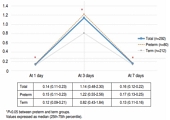
Purpose Although procalcitonin (PCT) level is useful for the diagnosis of neonatal sepsis, PCT reliability is inconsistent because of the varied conditions encountered in neonatal intensive care units. This study aimed to investigate PCT levels and factors influencing increased PCT levelin newborns without bacterial infection during the first week of life.
Methods In newborns hospitalized between March 2013 and October 2015, PCT levels...
- Cardiology
- Predictive factors of resistance to intravenous immunoglobulin and coronary artery lesions in Kawasaki disease
- Hye Young Lee, Min Seob Song
- Clin Exp Pediatr. 2016;59(12):477-482. Published online December 31, 2016
-
Purpose We conducted a study to determine which factors may be useful as predictive markers in identifying Kawasaki disease (KD) patients with a high risk of resistance to intravenous immunoglobulin (IVIG) and developing coronary artery lesions (CAL).
Methods We enrolled 287 patients in acute phase of KD at a single center. The demographic, clinical and laboratory data were collected retrospectively.
Results There were 34 patients...
- Pulmonology
- Clinical predictors of chest radiographic abnormalities in young children hospitalized with bronchiolitis: a single center study
- Ga Ram Kim, Min Sun Na, Kyung Suk Baek, Seung Jin Lee, Kyung Suk Lee, Young Ho Jung, Hye Mi Jee, Tae Hee Kwon, Man Yong Han, Youn Ho Sheen
- Clin Exp Pediatr. 2016;59(12):471-476. Published online December 31, 2016
-
Purpose Chest radiography is often performed on patients hospitalized with typical clinical manifestations of bronchiolitis. We aimed to determine the proportion of subjects with pathologic chest radiographic findings and the clinical predictors associated with pathologic chest radiographic findings in young children admitted with the typical presentation of bronchiolitis.
Methods We obtained the following data at admission: sex, age, neonatal history, past history of...
- Case Report
- Neurology
- Paroxysmal kinesigenic dyskinesia in a patient with a
PRRT2 mutation and centrotemporal spike discharges on electroencephalogram: case report of a 10-year-old girl - Sun Young Seo, Su Jeong You
- Clin Exp Pediatr. 2016;59(Suppl 1):S157-S160. Published online November 30, 2016
-
Coexistence of paroxysmal kinesigenic dyskinesia (PKD) with benign infantile convulsion (BIC) and centrotemporal spikes (CTS) is very rare. A 10-year-old girl presented with a 3-year history of frequent attacks of staggering while laughing and of suddenly collapsing while walking. Interictal electroencephalogram (EEG) revealed bilateral CTS, but no changes in EEG were observed during movement. The patient's medical history showed afebrile...
- Glucose transport 1 deficiency presenting as infantile spasms with a mutation identified in exon 9 of
SLC2A1 - Hyun Hee Lee, Yun Jung Hur
- Clin Exp Pediatr. 2016;59(Suppl 1):S29-S31. Published online November 30, 2016
-
Glucose transport 1 (GLUT-1) deficiency is a rare syndrome caused by mutations in the glucose transporter 1 gene (
SLC2A1 ) and is characterized by early-onset intractable epilepsy, delayed development, and movement disorder.De novo mutations and several hot spots in N34, G91, R126, R153, and R333 of exons 2, 3, 4, and 8 ofSLC2A1 are associated with this condition. Seizures,...
- Genetics and Metabolism
- A nonsense
PAX6 mutation in a family with congenital aniridia - Kyoung Hee Han, Hye Jin Lee, Il-Soo Ha, Hee Gyung Kang, Hae Il Cheong
- Clin Exp Pediatr. 2016;59(Suppl 1):S1-S4. Published online November 30, 2016
-
Congenital aniridia is a rare ocular malformation that presents with severe hypoplasia of the iris and various ocular manifestations. Most cases of congenital aniridia are known to be related to mutations in the paired box gene-6 (
PAX6 ), which is an essential gene in eye development. Herein, we report a familial case of autosomal dominant congenital aniridia with four affected members...
-

-
-

-

-
Impact Factor4.2
-
6.52022CiteScore92nd percentilePowered by







